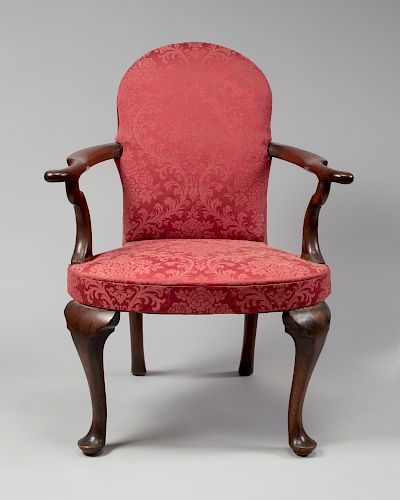IMPORTANT QUEEN ANNE LOW BACK UPHOLSTERED MAHOGANY OPEN ARMCHAIR , Probably New York, 1745-1760
Lot 34
About Seller
Keno Auctions
127 East 69th Street
New York, NY 10021
United States
Keno Auctions is renowned for our expertise in fine and decorative arts. With more than 30 years experience, founder Leigh Keno has established a brilliant team of experts specializing in fine art, furniture, decorative arts and jewelry.
Categories
Estimate:
$20,000 - $60,000
Absentee vs Live bid
Two ways to bid:
- Leave a max absentee bid and the platform will bid on your behalf up to your maximum bid during the live auction.
- Bid live during the auction and your bids will be submitted real-time to the auctioneer.
Bid Increments
| Price | Bid Increment |
|---|---|
| $0 | $25 |
| $100 | $100 |
| $2,000 | $250 |
| $5,000 | $500 |
| $30,000 | $2,500 |
| $50,000 | $5,000 |
| $100,000 | $10,000 |
| $500,000 | $10,000 |
| $1,000,000 | $10,000 |
About Auction
By Keno Auctions
Jan 24, 2020
Set Reminder
2020-01-24 15:00:00
2020-01-24 15:00:00
America/New_York
Bidsquare
Bidsquare : Important Americana – Featuring Furniture and Folk Art from a Distinguished NY Collection
https://www.bidsquare.com/auctions/keno/important-americana-featuring-furniture-and-folk-art-from-a-distinguished-ny-collection-4838
Keno Auctions Leigh@kenoauctions.com
Keno Auctions Leigh@kenoauctions.com
- Lot Description
The back with an arched crest rail above s-curved slightly sloping arms with scooped arm rests ending in horizontally scrolled handholds, above serpentine, crooked arm supports leading to an upholstered balloon seat above cabriole front legs ending in pad feet and raked, rounded rear legs Notes and Related Literature: This previously undocumented chair relates to a small group of chairs, each having upholstered backs and seats, open arms and cabriole legs ending in pad feet. The chair is most similar to the well-known pair at the Metropolitan Museum of Art (see Morrison H. Heckscher, American Furniture in the Metropolitan Museum of Art - Late Colonial Period: The Queen Anne and Chippendale Styles (New York, 1985), pp. 115-117, no. 67). Aside from the spiraled, scroll-carved handholds on the Metropolitan Museums pair, the proportions, distinctive _crookedÓ arm-supports, broad upper knee narrowing to a delicate ankle and raked, tapering rear legs which flare slightly at their bottoms, are similar on both the Metropolitan Museum chairs and the present chair. A chair at Winterthur (see Joseph Down, American Furniture: Queen Anne and Chippendale Periods in the Henry Francis DuPont Winterthur Museum (New York, 1952), fig. 16) shares these characteristics, yet has a higher, wider, flared back. Other chairs in the group include a pair at Winterthur with raking rear legs that do not taper before they flare and front legs with slightly heavier ankles than the aforementioned pair of chairs from the Met and the present chair (see Down, fig. 17). The two other published chairs from this group were sold previously by Israel Sack, Inc. The first, from the Davis Collection, has proportions that are similar to the Winterthur chair (Down's, fig. 17). The second has arm supports that are serpentine in shape, but are not crooked like others in the group (see American Antiques from Israel Sack Collection (Washington, DC, 1974), Vol. V, p.1190, p. 4125 and pp. 1322, 1323, P4342). Dimension H. 36 in., W. 26 1/2 in., D. 20 in. Medium: Secondary Woods: Ash, white pine (not by microanalysis). Provenance: Leigh Keno American Antiques, May 24, 1991 A Distinguished New York Collection of American Furniture and Folk Art. Literature: Robert Bishop, The American Chair - Three Centuries of Style (New York, 1983), pp. 112, 113, figs. 120, 122. Helen Comstock, American Furniture - Seventeenth, Eighteenth and Nineteenth Century Styles (New York, 1962), p. 85, no. 144. Marion Day Iverson, The American Chair 1630-1890 (New York, 1957), p. 84, fig. 65.The chair is in a remarkable state of preservation. A small section of the ash back frame where it meets the right arm support is missing. A small piece of wood is missing where the right arm meets the back frame. A small groove from a saw cut (probably the cabinetmaker's error) has been filled with a strip of walnut across the right knee. Several rose-head nails remain from earlier upholstery. Fragments of red wool (probably the original fabric) are beneath three of the rose-head nails. A remnant of the original muslin under-upholstery is at the lower back, secured by original rose-head nails. The front glue blocks are missing (judging from blocks on other chairs in the group and from the shadows on the present chair, they were triangular in shape).
Condition
- Shipping Info
-
Buyer Pays Shipping Cost
-
- Buyer's Premium



 EUR
EUR CAD
CAD AUD
AUD GBP
GBP MXN
MXN HKD
HKD CNY
CNY MYR
MYR SEK
SEK SGD
SGD CHF
CHF THB
THB





























